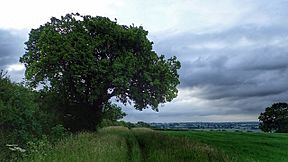Cubbington Pear Tree facts for kids
Quick facts for kids Cubbington Pear Tree |
|
|---|---|

The Cubbington Pear Tree in June 2015
|
|
| Species | European wild pear (Pyrus communis var. communis) |
| Location | Cubbington, Warwickshire, England |
| Coordinates | 52°18′41″N 1°29′01″W / 52.3113°N 1.4836°W |
| Date seeded | circa 1760 |
| Date felled | 20 October 2020 |
The Cubbington Pear Tree was a special wild pear tree that grew near Cubbington in Warwickshire, England. It was about 250 years old, making it one of the oldest wild pear trees in the whole country. Many people in the area knew and loved this tree.
In 2015, the Cubbington Pear Tree was even voted England's Tree of the Year. However, a new fast train line called High Speed 2 (HS2) was planned to go right through where the tree stood. People tried to save it, and a special online petition got over 20,000 signatures. Sadly, the tree was cut down on 20 October 2020 to make way for the railway.
Contents
About the Cubbington Pear Tree
The Cubbington Pear Tree was a type of tree called Pyrus communis var. communis. It was listed in a special book called the Champion Tree Register. This book keeps track of the biggest or oldest trees in the country.
The tree grew on top of a hill, close to a forest called South Cubbington Wood. Even though it was on private land, people could see it from a public walking path. Experts believed the tree was around 250 years old. It might have been the oldest wild pear tree in the United Kingdom.
It was also the second largest wild pear tree in the country. Its trunk measured about 3.78 metres (12.4 ft) around. Even at its old age, the tree continued to grow beautiful blossoms and tasty fruit every year until it was cut down.
The HS2 Railway Project
In 2011, the Cubbington Pear Tree was identified as being in the way of the planned High Speed 2 (HS2) railway line. This new line was being built to connect London and Birmingham. The pear tree was one of about 20 pear trees threatened by the project.
Experts from the Warwickshire Museum visited the tree to study it. They wanted to record information about it before any work began. HS2 officials said the tree could not be moved because its lower trunk was hollow.
Instead, they suggested taking small pieces, called cuttings, from the tree. They planned to grow new pear trees from these cuttings. These new trees would then be planted nearby as a replacement. The main trunk of the old tree was also going to be placed in South Cubbington Wood. This would create a home for insects, fungi, and other plants.
Efforts to Save the Tree
Many people did not want the tree to be removed. A group called the Cubbington Action Group strongly opposed the plan. They suggested that the train line should go underground in a tunnel instead of cutting through the area.
This idea was sent to a special group in Parliament called the HS2 Parliamentary select committee. However, the plan for a tunnel was rejected. It was considered too expensive, costing an estimated £46 million.
Even though the tree was likely to be cut down, efforts were made to preserve its legacy. By September 2017, Shuttleworth College successfully grew new trees from cuttings taken from the Cubbington Pear Tree.
In April and May 2018, the Cubbington Action Group organized walks for people to see the tree. Many people came to see it in bloom for what they thought would be the "last time." Work on the HS2 project in that area started around May 2018.
Protests and Felling
In October 2019, some local residents set up a protest camp in South Cubbington Wood. They wanted to protect the Cubbington Pear Tree and other nearby woodlands.
In September 2020, an online petition was started to save the tree. It quickly gained a lot of support, with over 20,000 signatures. The government responded to the petition. They said that HS2 Ltd had looked at all possible ways to avoid removing the tree. But because of its age and condition, they said it had to be removed.
The government also stated that 40 new trees had been grown from the pear tree's cuttings. These new trees would be planted locally. They also planned to move the tree's stump and roots. This was done to give it a chance to regrow in a new spot.
Sadly, the Cubbington Pear Tree was cut down on 20 October 2020. Some of the wood from the tree was given to a local woodworker.
England's Tree of the Year
The Cubbington Pear Tree was entered into the English Tree of the Year competition in 2015. Over 200 trees were part of the competition that year. A panel of experts chose the Cubbington Pear Tree for the top 10 shortlist.
The public then voted for their favorite tree. The Cubbington Pear Tree won the competition with more than 10,000 votes. It beat other famous trees like the Ankerwycke Yew in Berkshire, the Boscobel Oak in Shropshire, and the Glastonbury Thorn in Somerset.
After winning, the Warwickshire Wildlife Trust called the tree a "poster-boy." This meant it became a symbol for all the trees along the HS2 route that were in danger from the project.
The tree then went on to compete in the 2016 European Tree of the Year competition. It finished 8th out of 15 entries, receiving 7,858 votes.

